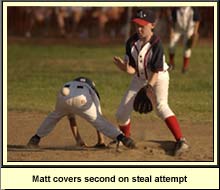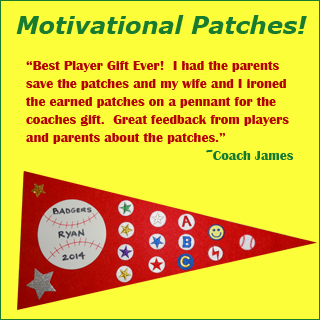Playing Second Base
No Runners On Base
Since the throw from the second base position is fairly short, you will be able to play fairly deep with no runners on base. Make sure you are not so deep that you have to hurry on a routine ground ball in order to make the out, or you can't get to first on time if the first baseman has to field a bunt.
Runner On First
With a runner on first you will want to take a few steps in toward home plate and a couple of steps toward second base. This will put you in position to cover second on a double play, force out, or steal attempt if you are covering on the play.
Covering Second on a Steal Attempt
Normally the second baseman will cover second on a steal attempt with a right-handed batter at the plate and the shortstop will cover second when a left-handed batter is up. Try to position yourself so you can still cover your area, but not so far away from second that you have to sprint to second to get there ahead of the runner. Once they see a runner stealing, I teach my players to shuffle towards second until the ball has crossed the plate, then to run hard to cover the base. By shuffling the first couple of steps they are still squared up to home and can stop and go quickly to their left if the ball is hit that way. This is something that really needs to be practiced with the catchers throwing down in order for your players to get a good feel for the timing required.

Double Plays
When the ball is hit in your direction and you believe you have a chance to turn a double play, make sure you don't rush. While a double play can be a savior for your pitcher and your team, you must make sure you at least get the lead runner. An error that results in no outs and possibly a runner on third can lead to a big inning for the opposing team. Concentrate on fielding the ball cleanly and making a good throw to the shortstop. If you can do this quickly but under control then you have given your team at least one out and the opportunity to get two.
Ball Hit Directly At You
When the ball is hit at you, you will want field the ball with your right foot slightly behind your left. This will allow you to easily pivot and throw because your hips will already be slightly open.
Once you have fielded the ball cleanly, you have two options for delivering the ball to the shortstop:
- With the first option, you will rotate your hips open toward second base as you bring the ball up from your glove. Your right foot will drop back to allow you to rotate farther and get more on the ball. Many players will move both feet at the same time to quickly open up and deliver the ball.
- The other option is rotate your hips open toward second, dropping your left knee to the ground in the direction of second and throwing from your knee. Younger players may find that they are more accurate using this method. It will probably take you longer to deliver the ball using this method, but if you can make a more accurate throw to the shortstop then it's worth the extra time.
Ball Hit To Your Right
On this play you will normally be close enough to underhand the ball to the shortstop. Since you are going to your right, you should naturally be in a position where your right foot is slightly behind your left. This is the position your want to be in. Once you have fielded the ball, you will pivot on your right foot, clear your glove (this will give the shortstop a clear view of the ball), and deliver the ball. When tossing the ball underhanded you want to keep your wrist stiff, your arm motion will provide the power behind the toss. As your arm makes the underhand throwing motion, you will want to follow your throw with your left leg. This will help you deliver an accurate throw to second.
With both of the plays described above, it's important to remember that they should look seamless. Which in these cases means they should be performed from the crouching position. You don't want to catch the ball, stand up, and then rotate and underhand it. Simply field the ball, rotate from that position and deliver the ball.
Ball Hit To Your Left (Assuming You Are Fielding It On Your Glove Hand Side)
On this ball that takes you away from where you are going to throw the ball, you will want to field the ball, plant your right foot, pivot to your left and throw the ball to second. It's important that you don't whirl and throw blindly back to second. After you have planted your right foot, turn your head and pick up your target prior to throwing the ball. If you have any doubt about having enough time to get the runner at second, just throw the ball to first and get the sure out. A wild throw that pulls the shortstop off of second and results in not getting an out, means you were rushing the play and probably should have just made the out at first. Physical errors will happen, but sometimes they are the direct result of a poor decision.
Ball Hit To The Third Baseman Or Shortstop
With the ball hit to the left-hand side of the infield, you will most likely be the pivot man at second base. The only exception is when the shortstop is close enough to make the play unassisted. There are a number of ways for you to receive the ball and make the throw to first. Which method you use will be determined by the location of the throw and your position around the bag when the ball is on its way.
Straddle
One method is to straddle second base. You can use this method when you have gotten to the base quickly and the throw is on target. Position your feet on each side of second base and as you catch the ball you will take a short step with your left foot and throw to first. When using this method you are never really touching the base. Most umpires will not be in a position to notice and even if they did they most likely wouldn't call it. But, at lower levels such as little league, you never know. If you are concerned, either don't use this method or get in a habit of dragging your right foot over the bag as you follow throw with your throw.
The other problem with the straddle method is that it puts you in a vulnerable position as you are waiting for the ball. If the fielder drops the ball or has some other problem and you forget to move, you are exposed to taking a cleat in the side of your leg and if the slider comes up with his cleat your knee is in a vulnerable position to injury.
Left Foot
Another method is to use your left foot on second base. This method will allow you to go in any direction and get a good quick throw off. As you approach second base, breakdown your steps a few feet from the bag. This will allow you to time the actual step on second with your left foot and determine how your going to move off that foot.
There are a number of ways you can turn the double play from your left foot. Again, the location of the throw and when you arrive at second will determine what method you will use.
- You're at second early, throw is on target.
Normally this will occur when the throw is coming from the third baseman. In this case you will plant your left foot on second and step across the bag catching the ball as your right foot lands. From there it's just a step towards first with your left leg and a throw. - You're at second early, throw is to your right.
This throw is going to take you behind second base and by using your left foot on the bag, this is an easy play. You will plant your left foot an push off on to your right foot behind the bag while catching the ball. From there just take a small step with your left leg and throw the ball to first. - You're at second in normal time, throw is on target. On this play you're not at the base early enough to cross over and make the throw, so you will want to use your left leg to push you back off the base where you will plant your right leg, step and throw. At first you might think this would be a slow way to turn a double play and that you would just want to use your right leg on the base and just step and throw. The key here is the timing. If you are on the base before you catch the ball, you can actually be pushing back with your left leg and planting with your right as you catch the ball. This will result in a very quick throw.
- You're at second in normal time, throw is to your right.
In this case you may need to go get the ball prior to touching the bag with your left foot. Try to catch the ball so your behind second in a direct line with first base. This will allow you to catch the ball and as you step to throw you will step on second base with your left foot. The key with this play is being aware of where the runner is. If you have a fast runner at first, you may be allowing him to slide into second safely as you go get the ball. Sometimes you have to abandon the double play and just get the out.
Right Foot
You will use your right foot on the bag when either the throw is to the left of the bag or you're late getting to the bag and the ball arrives before you. In the second case you will catch the ball on your way to second and when you get there you will step on the bag with your right foot, step toward first with your left and throw.
Low Throw
Occasionally the feed will be very low or in the dirt. This is a difficult ball to turn two on. Come across second base and try to catch the ball in front of the base. You will be acting more like a first baseman with this type of throw. In this situation you want to make sure you get the out at second.
Avoiding The Runner
With all the throws you make to first you have to always be aware of avoiding the runner that is coming at you. The first key to avoiding injury is to always point your left toe toward first when you make the throw. This will point your kneecap in the direction of the runner which is a less vulnerable position then having the side of your leg exposed.
The best method to avoid the runner sliding into second base is to hop on your left leg after making the throw and jumping over the oncoming runner. You'll often see second baseman who practice this hop whenever they practice turning the double play. Having confidence in your ability to get out of the way of a sliding runner will add to your confidence in turning a double play.
Most Recent Blog Posts
Working With Players on Focusing on the Correct Part of the Baseball when Hitting (October 15 2016)
Getting More Accurate Throws From Your Team (April 5 2016)
Youth Coaching Advice
Younger players may have difficulty with both methods, so it may be necessary for them to shuffle their feet in order to make this throw accurately. Make sure that you emphasize the importance of making a good throw and getting the out at second.
Thanks for all the great information and drills! I've used the site all season and it's made my life so much easier.
- Jim N.
Youth Coaching Advice
Because of the exposed position the straddle method puts the player in, it's not recommended that young players use the straddle method. All second baseman need to be able to use the other pivot methods shown, so have young players work on those pivots.







